After Upending the Global Oil Industry & Losing Their Shirts, Shale Oil Drillers & Battered Investors Go for Price
US oil drillers have refused to raise production back to 2019 levels, despite the recovery in the price of oil

Production of US crude oil, including condensate, in May, at 11.2 million barrels per day, was still down 13% from the peak in late 2019 and back at July 2018 levels, according to EIA data released on Friday. What is fascinating – given how US production doubled over the past decade, reducing US imports from OPEC to nearly nothing (more on that in a moment), crushing the price of oil, and crushing in the process investors in the US oil sector – is how oil drillers in the US, and their battered investors, have refused to raise production back to 2019 levels, despite the recovery in the price of oil.
Production over the past six months was down 17.4% from production over the six months through March 2020.
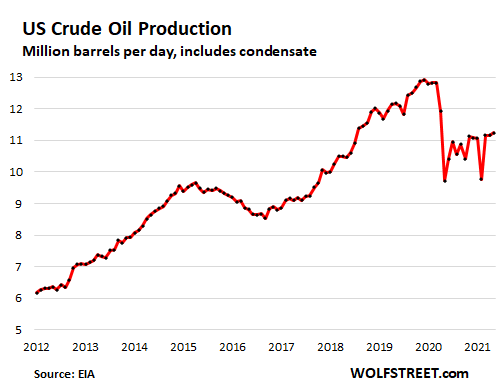
The price of oil recovers — partially.
The sudden plunge in production in the spring last year and the partial recovery since then looks very different from what transpired during the beginning of the Great American Oil Bust. Production began to fall in April 2015 and continued to fall gradually through September 2016, before starting to rise again. During that time, the price of oil collapsed, with West Texas Intermediate plunging from over $100 a barrel in mid-2014 to $26 a barrel in April 2016. And numerous oil field companies filed for bankruptcy.
The cutback in production this year – rumored to be due to the newly found “discipline” in the Oil Patch – has reduced overproduction in the US. The price of WTI futures, which had collapsed into the negative for a brief moment in April 2020 for the first time in history, has rocketed higher and has been trading mostly above $70 a barrel since early June ($71.42 at the moment):
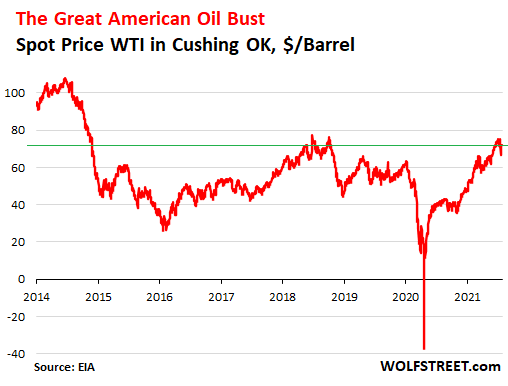
OPEC shoved aside.
Imports from OPEC started plunging as the fracking boom in the US took off. Back in mid-2008, the US was still importing over 5.5 million barrels per day from OPEC. By November 2020, imports from OPEC had collapsed to 0.5 million barrels per day. In May, imports from OPEC were 0.9 million barrels per day. This range is the lowest in the EIA data going back to 1973:
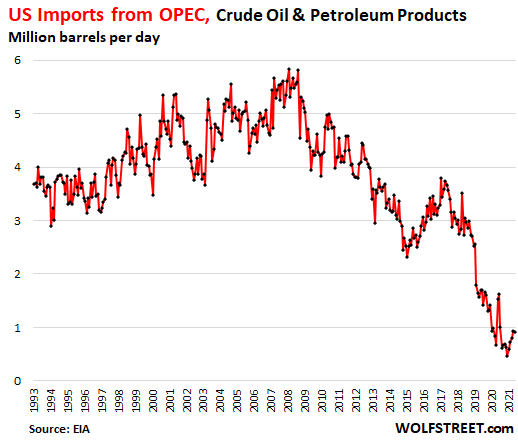
Exports of crude oil and petroleum products soared until they didn’t.
In late 2015, the US Congress lifted the export ban on US crude oil, as the price of crude oil was plunging. Before then, with the ban in effect, the US could export crude oil to certain countries and could export petroleum products globally. But in early 2016, the crude oil export valves were opened all the way, crude oil exports surged from less than 0.5 million barrels a day in 2015 to 3.7 million barrels per day in February 2020.
But since the plunge in early 2020, exports of crude oil have not really recovered (red line in the chart below).
Exports of the overall category of “crude oil and petroleum products” have been rising steadily with the fracking boom for over a decade, and reached 10 million barrels per day in February 2020. But after the plunge in early 2020, they have only partially recovered (purple line).
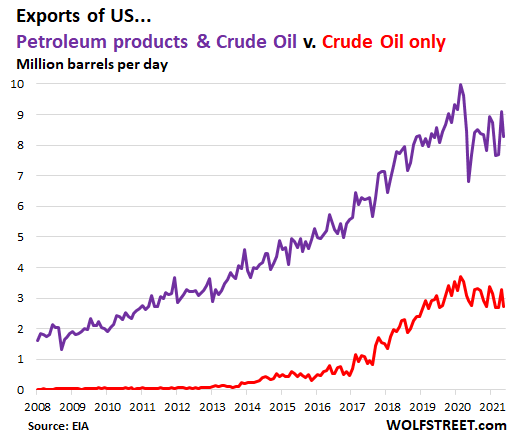
US now net exporter of “crude oil & petroleum products.”
Imports of overall crude oil and petroleum products, minus exports of these products, results in the “net imports.” This figure was positive for many decades, with net imports reaching a peak of over 13 million barrels a day in mid-2006.
It has since tumbled due to the surge in exports and the plunge in imports, and in October 2019, for the first time, the US exported more than imported. This trend has continued, and the US thereby has become a net exporter of “crude oil & petroleum products.”
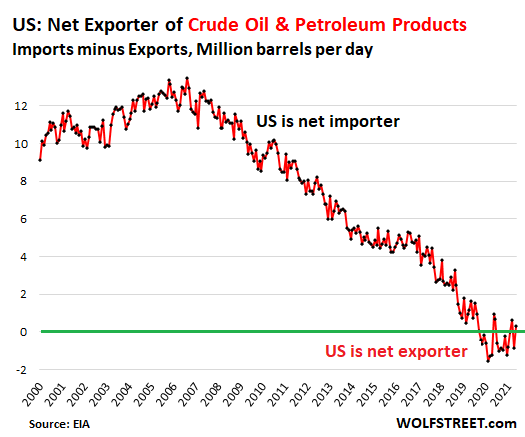
In terms of crude oil by itself, the US still imports more crude oil than it exports, but these net imports of crude oil have tumbled by over 70% from a peak of 10.5 million barrels a day in 2006 to a range of 2.1 – 3.1 million barrels per day:
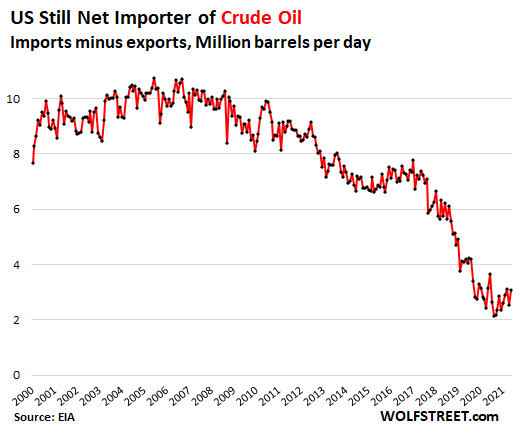
This new-found discipline in production, in a period of reduced demand, has helped push the price back up to a survivable level for the US oil patch. This discipline didn’t come easy. It was forced on the industry by a slew of bankruptcies and by battered investors who had had enough with the philosophy that they needed to fund production growth at any cost.
A similar scenario is playing out in the US natural gas sector, where production is still down, exports are booming, and prices have been rising.
Source: Wolf Street

Au contraire! The “discipline” was forced on them by the corrupt White House and its communist allies who have made it clear that production increases won’t be tolerated in the new “Green” economy.
Simplistic “realpolitik” at its best. Washington decides nothing their paymasters at the Federal Reserve Bank does not tell them to. I shall not assail your belief that the Fed is a State organ now, I have to go talk to some grownups…
“But since the plunge in early 2020, exports of crude oil have not really recovered”
The world (Europe, China, Asia, S. America) has been much more successful in demolishing their economies than the U.S has. Some growth in the U.S., no growth in the rest of the world, hence lower appetite for U.S. crude.
tunamelt, please explain how the US economy has grown, and the rest imploded. For extra marks, please tell us how the world’s “appetite for US crude” changed, when we get our oil out of the Middle East, not America.
For bonus marks, please tell us how China’s economy has lagged the US.
Bombing Syria, Iraq, Jordan, Libya and Iraq so you can steal their oil, does not count as “US production”, boyo!
Follow prices in financial markets. Gold, Euro currency, silver, and chinese equities are a disaster. Oil prices were 3 times the price then in 2011 then now.
This is partly because china’s growth is paltry. China is not the grower it once was. They have huge dollar debts. They must earn those dollars to pay it! The world has more phony virus restrictions than USA. The US economy is slightly better. Take the political blinders off and look at markets with buyer and sellers not stupid government statistics. You are looking in the review mirror!
The world including China is locked down because of the WEF. For whatever reason, the Globalists have most foreign countries in handcuffs.
Vietnam threw several foreign countries out of their nation, but they bow and scrape to the WHO and the WEF. No foreign country, I see is opening up and looking to do business. They all are at home cowering with fear.
In USA, there are regions that are opened up and doing business. Look at the red states not the blue state morons. Its a relative growth story. Some growth in the USA, and nothing but stay at home abroad.